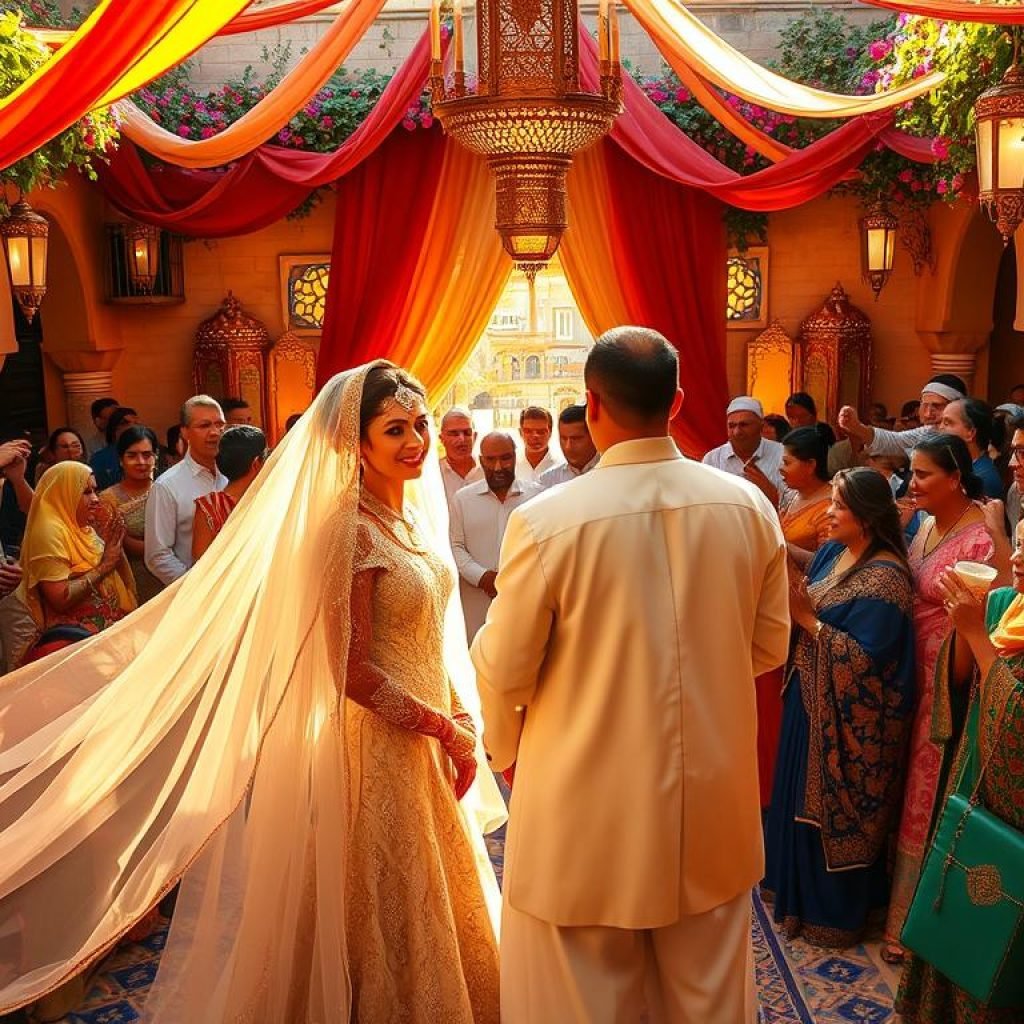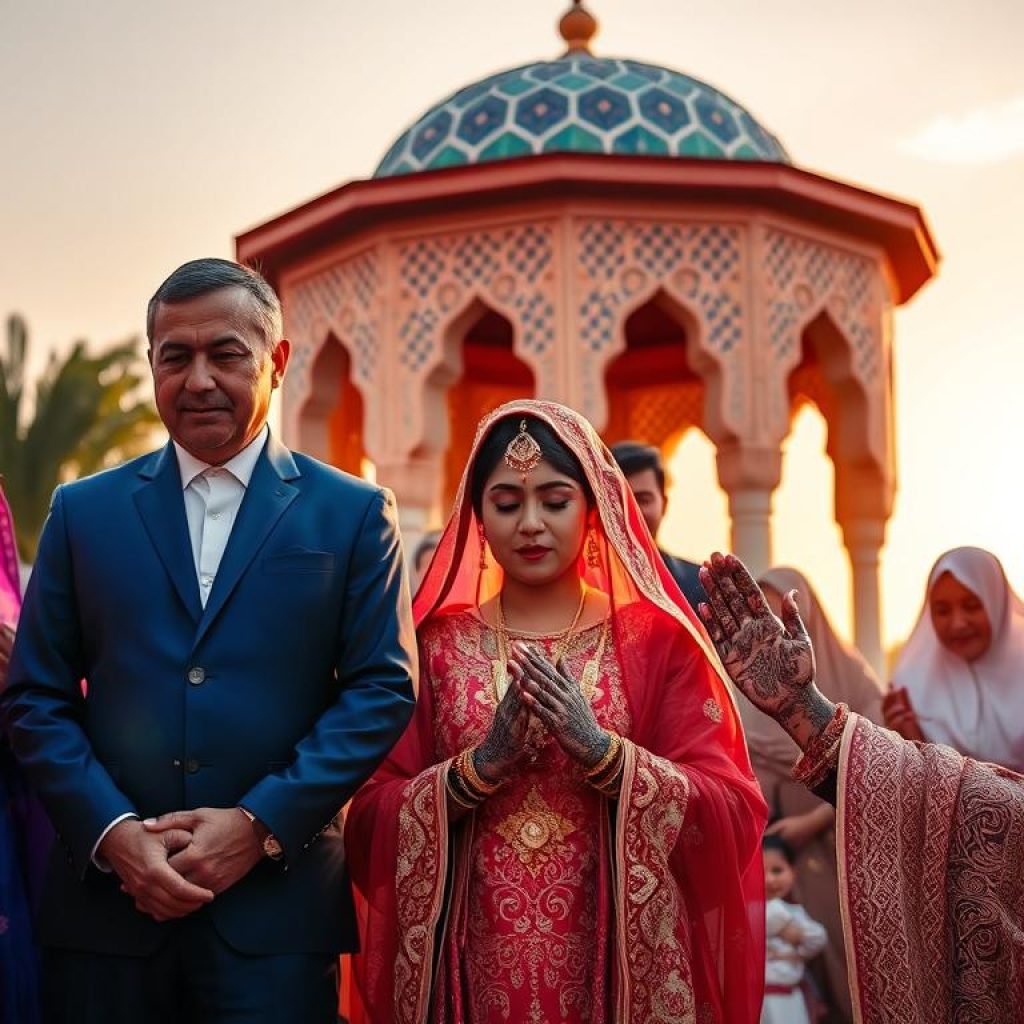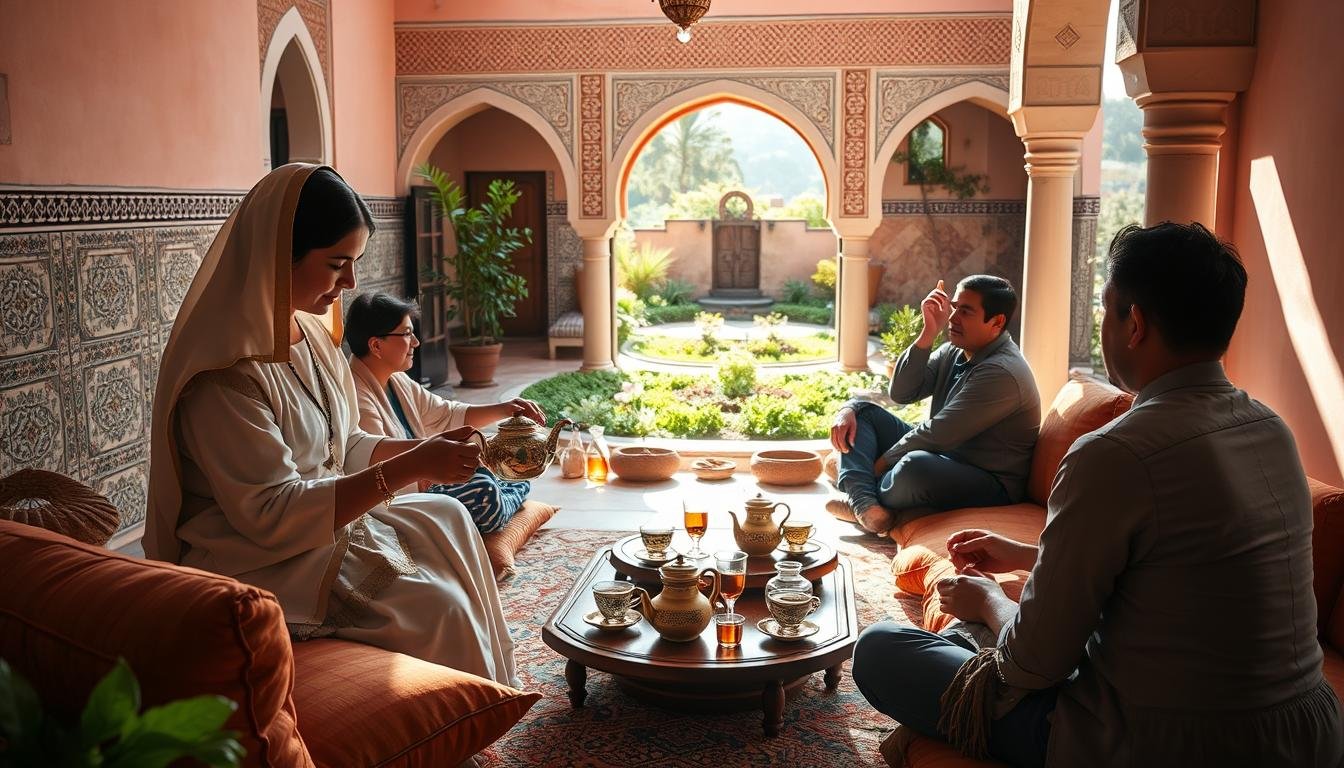What role does tea play in Moroccan wedding traditions? How does it bring people together in Moroccan weddings? Tea is key in Moroccan marriage customs, showing more than just a wedding day significance. In Moroccan culture, tea stands for hospitality, respect, and community.
From the traditional Moroccan mint tea recipe to the ceremonial act of pouring tea, every step is filled with tradition and meaning.
In Moroccan weddings, tea is a sign of respect and hospitality. The height of the tea pour can even show if a woman accepts or rejects a marriage proposal. Tea’s rich history and cultural importance make it a vital part of Moroccan wedding traditions and weddings. Knowing about tea in Moroccan marriage customs offers a glimpse into the country’s rich cultural heritage and the value of marriage in society.
Introduction to Moroccan Wedding Traditions
Moroccan wedding traditions are full of vibrant customs and ancient rituals. The celebration can last for several days, filled with ceremonies and rituals, including the traditional Moroccan tea ceremony. Tea is a big part of these customs, with its importance going beyond the wedding day.
Key Takeaways
- Tea plays a significant role in Moroccan wedding traditions and Moroccan weddings.
- The traditional Moroccan mint tea recipe is an essential part of Moroccan marriage customs.
- The height of the tea pour can indicate a woman’s acceptance or rejection of a marriage proposal.
- Tea is a symbol of hospitality, respect, and community in Moroccan culture.
- Understanding the role of tea in Moroccan marriage customs can provide insight into the country’s rich cultural heritage.
- Moroccan wedding traditions are known for their vibrant customs and time-honored rituals.
- Tea is an integral part of Moroccan weddings, and its significance extends beyond the wedding day.
Introduction to Moroccan Wedding Traditions
Moroccan wedding traditions are colorful and complex, deeply rooted in the country’s history. They are still celebrated today. At the core of these customs is the family’s role, where marriage is seen as a union between two families, not just two people.
A traditional Moroccan wedding is a big event, lasting several days. It’s filled with music, dance, and celebration. The bride changes outfits many times, showing the joy and festivity of the occasion. Family members play a big part in the wedding, showing the importance of family in Moroccan culture.
Important parts of Moroccan weddings include the henna party. Women get their hands and feet decorated with henna, symbolizing good luck and happiness. The marriage contract, or Akd, is signed on a special day, surrounded by family and an Adoul. These traditions highlight Morocco’s rich cultural heritage.
Learning about Moroccan wedding customs helps us see their beauty and importance. By following these traditions, couples can have a wedding that celebrates family and community, making their day truly special.
The Role of the Bride in Moroccan Weddings
In Moroccan weddings, the bride is at the heart of the celebration. Her preparations and clothes are key parts of the event. The bride’s journey starts with the hammam day, where she and her loved ones go to the public bath. This is a big tradition in Moroccan bridal traditions, showing the value of beauty and purity before marriage.
The bride’s clothes are also a big deal, showing off the country’s rich textile culture and her status. She might wear up to 7 different outfits, each one chosen to highlight her beauty and grace. These outfits show the authentic Moroccan wedding practices, where the bride’s clothes reflect her family’s wealth and standing.
The bride’s preparations and clothes are just a few examples of the many Moroccan wedding celebration customs that make these weddings special. From the hammam day to the wedding ceremony, every part of the celebration is filled with tradition and cultural meaning. Whether it’s the bride’s intricate henna designs or the groom’s fancy clothes, every detail is thought out to make the celebration memorable and joyful.
The Groom’s Role in Moroccan Weddings
In Moroccan weddings, the groom has a big role. His preparations and customs show the country’s rich culture. He wears traditional clothes like the jabador and djellaba to show his status and the importance of Moroccan wedding customs.
The groom gives expensive gifts, like jewelry and clothes, to the bride’s family before the wedding. This shows his commitment to the marriage. His family also helps pay for the wedding, including the dowry and gifts, as part of the ketba negotiations.
Some key aspects of the groom’s role in Moroccan weddings include:
- Participating in pre-wedding celebrations, such as the henna ceremony
- Wearing traditional attire, like the djellaba, on the wedding day
- Presenting gifts to the bride’s family during the engagement stage
- Bearing most of the wedding costs, including the dowry and gifts
Understanding the groom’s role in Moroccan weddings gives insight into the country’s rich culture. By embracing these customs, couples can have a unique and memorable wedding. It honors their heritage and traditions.
Moroccan Wedding Ceremonies and Rituals
Moroccan wedding ceremonies are full of life and tradition. They show the country’s rich culture. These ceremonies are key to the couple’s journey to marriage. Moroccan weddings have many rituals, each with its own special meaning.
A Moroccan wedding lasts three days. Each day has its own ceremonies and celebrations. The first day is the Hammam and Henna Ceremony, or “Laylat Al-Henna.” Friends and family come to apply henna designs.
The second day is the “Zaffa.” It’s a big procession with musicians, drummers, and dancers. This creates a lively atmosphere.

The Marriage Contract Ceremony
The marriage contract ceremony is a big step. The bride and groom sign a contract in front of their families and an imam. This marks their commitment to each other.
The Henna Ceremony
The henna ceremony is for the bride and her female friends and family. They apply henna to the bride’s hands and feet. It’s a big part of traditional Moroccan wedding customs and means good luck and fertility.
The Wedding Party and Celebration
A Moroccan wedding is a big event filled with music, dance, and food. The bride’s entrance is a big moment, carried in an “amaria” by bearers. They are accompanied by Moroccan wedding music and cheers.
The Moroccan wedding celebration includes many dishes, sweets, and drinks. Music and dance are key, with chaabi and Andalusian music being favorites. A typical dinner might have grilled chicken and lamb tagine, or one dish with Seffa.
The Moroccan wedding party brings families and friends together. It starts around 9 PM and goes until 5 or 6 AM. Breakfast is served at the end. Live music, especially “chaabi” and “Ala” music, is a big part of the celebration.
Traditional Moroccan Wedding Food and Drinks
Moroccan wedding food is endless and delicious. Traditional Moroccan cuisine is known for its rich flavors and aromas. Wedding celebrations are no exception. Every dish is carefully prepared to delight the guests.
The cost of plated dinners for Moroccan weddings can start at 50 euros per person. The menu often features traditional dishes like tagines, couscous, and pastilla. These dishes are delicious and show the country’s rich culinary heritage.
Mint tea and Coca Cola are popular drinks at Moroccan weddings. The wedding feast, known as “L’Ftou,” features a wide variety of Moroccan delicacies. This includes tagines, couscous, pastries, and aromatic teas.
Appetizers and Main Courses
Traditional Moroccan wedding appetizers and main courses are a highlight. Some popular options include:
- Tagines: slow-cooked stews made with meat, vegetables, and dried fruits
- Couscous: a traditional North African dish made from steamed semolina flour
- Pastilla: a savory pie made with meat, onions, and spices
These dishes are served in a specific order. It starts with appetizers, then the main course, and ends with desserts and beverages. This makes the experience of Moroccan wedding food unforgettable.
Desserts and Beverages
Traditional Moroccan wedding desserts and beverages are a delight. Some popular options include:
- Milk pastilla: a sweet pastry made with milk, sugar, and spices
- Almond briouats: sweet or savory pastries made with almonds and honey
- Mint tea: a refreshing drink made with green tea, mint, and sugar
These desserts and beverages are a perfect way to end a delicious meal. They are often served alongside traditional Moroccan wedding drinks. This makes the experience even more enjoyable.
Moroccan Wedding Attire and Accessories
Moroccan wedding attire is key to the celebration. The bride wears seven traditional dresses, each from a different region. These dresses are paired with accessories like jewelry and headpieces, making the wedding attire even more special.
The bride’s traditional clothes include the green and golden caftan and the white takchita. The groom wears a Jabadour, showing pride and dignity. Their outfits are chosen to match and highlight their status and the occasion.
- The sahraouia dress, which is composed of a Mlehfa that is four meters wide and 61 centimeters long
- The chamalia dress, which consists of two superimposed caftans and is historically worn by female nobility in Tangier
- The Soussia dress, which reflects the unique patterns of different Amazigh tribes, with distinct clothing styles for each tribe
Moroccan wedding accessories, like the mdama and jewelry, are also vital. These are often worn with traditional clothes like the takchita and Jabadour. They add to the beauty and memorability of the wedding attire.
The Significance of Moroccan Wedding Customs
Moroccan wedding customs are filled with cultural and religious meaning. They show the country’s rich history. The marriage is not just between two people but also between their families. The rituals and ceremonies aim to strengthen these bonds.
Moroccan marriage traditions are key to the celebration. They highlight the importance of community and marriage in Moroccan society.
The cultural importance of Moroccan weddings is clear in their customs and traditions. For instance, the traditional wedding process can last up to seven days. The courtship period can range from six months to two years. These show the deep Moroccan wedding customs hold in the culture and society.
Some important parts of Moroccan wedding customs include:
- The Imilchil Moussem, a big wedding fair where over 30,000 Berbers come to celebrate and find spouses
- The use of traditional hand-made kaftans, which are now rare due to modern machines
- The henna ceremony, held one to two days before the wedding, is very important

In modern Moroccan weddings, the cultural significance of Moroccan weddings is still seen. Yet, some traditions have changed. For example, food is now often catered instead of made by family. The newlyweds might also choose to stay in a hotel for their first night instead of the traditional marriage chamber.
Despite these changes, the core of Moroccan wedding customs remains the same. They still emphasize family, community, and cultural heritage.
Modern Moroccan Weddings
Modern Moroccan weddings mix old customs with new ideas. This shows how the society is changing. Venues, clothes, and music are all updated to make the wedding special.
The celebration of Drib Sdak is a big part of these weddings. The bride and groom sign their marriage contract with family and an “Adoul” there. The pre-wedding party lasts 8 to 10 hours, with the groom’s family giving gifts like clothes and sweets.
On the big day, the bride might wear up to seven outfits. Each one shows a different Moroccan culture.
Some key features of modern Moroccan weddings include:
- A mix of old and new music, like Chaabi and Andalousi
- Modern and traditional clothes, with the bride wearing up to seven outfits
- New takes on old customs, like the Henna party and Hammam ritual
Even with these changes, the heart of Moroccan weddings stays the same. This balance of new and old makes the wedding both unique and meaningful. It shows the beauty of modern Moroccan weddings, blending old and new in a beautiful way.
Planning a Moroccan Wedding
Planning a Moroccan wedding takes several steps. You need to pick a venue and choose vendors and services. When planning a Moroccan wedding, remember the cultural and practical sides of the event. Moroccan wedding venues range from fancy riads in Marrakech to beautiful spots in Chefchaouen.
Choosing the right Moroccan wedding vendors is key. They should offer catering, music, and decorations. It’s also important to know the local customs and traditions.
Choosing a Venue
Popular Moroccan wedding venues include the Atlas Mountain Range, Fez, and Essaouira. Each place gives a unique and culturally rich setting for the wedding.
Selecting Vendors and Services
When picking Moroccan wedding vendors, look at their service quality. Make sure they can add traditional touches, like local music and food.
With good planning and the right vendors, your Moroccan wedding will be unforgettable.
Attending a Moroccan Wedding as a Guest
Attending a Moroccan wedding means understanding the customs and traditions. You’ll want to make a good impression by dressing right and following the etiquette. This includes dressing modestly and avoiding revealing clothes. Also, remember that the wedding often starts late in the evening.
Joining in the Moroccan wedding celebrations shows respect and appreciation. You can dance or sing along to the music. You can also take part in traditional rituals and ceremonies. This way, you’ll fully enjoy the experience and make memories that last.
Here are some important things to remember when attending a Moroccan wedding:
- Arrive fashionably late, as weddings often start at 8 PM or later
- Be ready for a long night, as dinner may not be served until midnight or later
- Respect the bride and groom’s traditions, including the henna party and the official start of the wedding festivities
- Join in the Moroccan wedding celebrations, such as dancing and singing along to the music
By following these tips and being mindful of Moroccan wedding guest etiquette, you’ll have a fun and memorable time at the wedding.
Conclusion: The Beauty of Moroccan Weddings
Moroccan wedding traditions are a mix of joy and deep cultural roots. They show the country’s rich heritage. From henna designs on the bride’s hands to traditional music, every part of the wedding is special.
At the core of these Moroccan wedding traditions is the importance of marriage. The rituals and customs are more than just pretty. They connect families and communities, celebrating love and unity.
As we end our look at the beauty of Moroccan weddings, we appreciate their value more. These lively celebrations open a window into Moroccan culture. They show the lasting impact of these traditions on Moroccan society, making them unforgettable.




Comment (0)